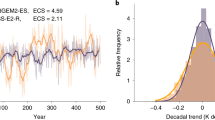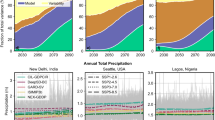Abstract
When considering adaptation measures and global climate mitigation goals, stakeholders need regional-scale climate projections, including the range of plausible warming rates. To assist these stakeholders, it is important to understand whether some locations may see disproportionately high or low warming from additional forcing above targets such as 2 K (ref. 1). There is a need to narrow uncertainty2 in this nonlinear warming, which requires understanding how climate changes as forcings increase from medium to high levels. However, quantifying and understanding regional nonlinear processes is challenging. Here we show that regional-scale warming can be strongly superlinear to successive CO2 doublings, using five different climate models. Ensemble-mean warming is superlinear over most land locations. Further, the inter-model spread tends to be amplified at higher forcing levels, as nonlinearities grow—especially when considering changes per kelvin of global warming. Regional nonlinearities in surface warming arise from nonlinearities in global-mean radiative balance, the Atlantic meridional overturning circulation, surface snow/ice cover and evapotranspiration. For robust adaptation and mitigation advice, therefore, potentially avoidable climate change (the difference between business-as-usual and mitigation scenarios) and unavoidable climate change (change under strong mitigation scenarios) may need different analysis methods.
This is a preview of subscription content, access via your institution
Access options
Subscribe to this journal
Receive 12 print issues and online access
$209.00 per year
only $17.42 per issue
Buy this article
- Purchase on Springer Link
- Instant access to full article PDF
Prices may be subject to local taxes which are calculated during checkout




Similar content being viewed by others
Change history
28 January 2015
In the version of this Letter originally published, the fourth author affiliation should have read '4Institute for Atmospheric and Climate Science, Department of Environmental Sciences, ETH Zurich, CH-8092 Zurich, Switzerland.' This error has been corrected in the online versions of the Letter.
References
Arnell, N. W. et al. A global assessment of the effects of climate policy on the impacts of climate change. Nature Clim. Change 3, 512–519 (2013).
Oppenheimer, M. Defining dangerous anthropogenic interference: The role of science, the limits of science. Risk Anal. 25, 1399–1407 (2005).
Gosling, S. N. et al. A review of recent developments in climate change science. Part II: The global-scale impacts of climate change. Prog. Phys. Geogr. 35, 443–464 (2011).
Todd, M. C. et al. Uncertainty in climate change impacts on basin-scale freshwater resources—preface to the special issue: The QUEST-GSI methodology and synthesis of results. Hydrol. Earth Syst. Sci. 15, 1035–1046 (2011).
Van Vuuren, D. P. et al. How well do integrated assessment models simulate climate change? Climatic Change 104, 255–285 (2011).
Moss, R. H. et al. The next generation of scenarios for climate change research and assessment. Nature 463, 747–756 (2010).
Huntingford, C. et al. Simulated resilience of tropical rainforests to CO2-induced climate change. Nature Geosci. 6, 268–273 (2013).
Chadwick, R., Wu, P. L., Good, P. & Andrews, T. Asymmetries in tropical rainfall and circulation patterns in idealised CO2 removal experiments. Clim. Dynam. 40, 295–316 (2013).
Li, S. & Jarvis, A. Long run surface temperature dynamics of an A-OGCM: The HadCM3 4 × CO2 forcing experiment revisited. Clim. Dynam. 33, 817–825 (2009).
Manabe, S., Bryan, K. & Spelman, M. J. Transient-response of a global ocean atmosphere model to a doubling of atmospheric carbon-dioxide. J. Phys. Oceanogr. 20, 722–749 (1990).
Meinshausen, M. et al. The RCP greenhouse gas concentrations and their extensions from 1765 to 2300. Climatic Change 109, 213–241 (2011).
Good, P., Gregory, J. M. & Lowe, J. A. A step-response simple climate model to reconstruct and interpret AOGCM projections. Geophys. Res. Lett. 38, L01703 (2011).
Good, P., Gregory, J. M., Lowe, J. A. & Andrews, T. Abrupt CO2 experiments as tools for predicting and understanding CMIP5 representative concentration pathway projections. Clim. Dynam. 40, 1041–1053 (2013).
Andrews, T. & Ringer, M. A. Cloud feedbacks, rapid adjustments, and the forcing-response relationship in a transient CO2 reversibility scenario. J. Clim. 27, 1799–1818 (2014).
Jonko, A. K., Shell, K. M., Sanderson, B. M. & Danabasoglu, G. Climate feedbacks in CCSM3 under changing CO2 forcing. Part II: Variation of climate feedbacks and sensitivity with forcing. J. Clim. 26, 2784–2795 (2013).
Colman, R. & McAvaney, B. Climate feedbacks under a very broad range of forcing. Geophys. Res. Lett. 36, L01702 (2009).
Hansen, J. et al. Efficacy of climate forcings. J. Geophys. Res. 110, D18104 (2005).
Ishizaki, Y. et al. Temperature scaling pattern dependence on representative concentration pathway emission scenarios. Climatic Change 112, 535–546 (2012).
Drijfhout, S. S., Weber, S. L. & van der Swaluw, E. The stability of the MOC as diagnosed from model projections for pre-industrial, present and future climates. Clim. Dynam. 37, 1575–1586 (2011).
Hall, A. The role of surface albedo feedback in climate. J. Clim. 17, 1550–1568 (2004).
Eisenman, I. Factors controlling the bifurcation structure of sea ice retreat. J. Geophys. Res. 117, D01111 (2012).
Seneviratne, S. I. et al. Investigating soil moisture-climate interactions in a changing climate: A review. Earth-Sci. Rev. 99, 125–161 (2010).
Seneviratne, S. I., Luthi, D., Litschi, M. & Schar, C. Land-atmosphere coupling and climate change in Europe. Nature 443, 205–209 (2006).
Field, C. B., Jackson, R. B. & Mooney, H. A. Stomatal responses to increased CO2—implications from the plant to the global-scale. Plant Cell Environ. 18, 1214–1225 (1995).
Chadwick, R. & Good, P. Understanding non-linear tropical precipitation responses to CO2 forcing. Geophys. Res. Lett. 40, 4911–4915 (2013).
Good, P. et al. A step-response approach for predicting and understanding non-linear precipitation changes. Clim. Dynam. 39, 2789–2803 (2012).
Collins, W. J. et al. Development and evaluation of an Earth-System model—HadGEM2. Geosci. Model Dev. 4, 1051–1075 (2011).
Martin, G. M. et al. The HadGEM2 family of Met Office Unified Model climate configurations. Geosci. Model Dev. 4, 723–757 (2011).
Acknowledgements
This work was supported by the Joint UK DECC/Defra Met Office Hadley Centre Climate Programme (GA01101). N.B. and J.M.G. received financial support from the European Research Council under the European Community’s Seventh Framework Programme (FP7/2007–2013), ERC Grant Agreement 247220, project ‘Seachange’. Simulations by J.L.D. were performed as part of the ANR ClimaConf project (grant no. ANR-10-CEPL-0003). H.S. was supported by the SOUSEI program from the Ministry of Education, Culture, Sports, Science and Technology of Japan and the Environment Research and Technology Development Fund (S-10) of the Ministry of the Environment of Japan. N.S. was supported by the Swiss National Science Foundation.
Author information
Authors and Affiliations
Contributions
P.G. conceived the study and wrote the paper. All authors contributed to the scientific interpretation and the paper. T.A., M.B.M., J.L.D., J.M.G., N.S. and H.S. performed experiments.
Corresponding author
Ethics declarations
Competing interests
The authors declare no competing financial interests.
Supplementary information
Rights and permissions
About this article
Cite this article
Good, P., Lowe, J., Andrews, T. et al. Nonlinear regional warming with increasing CO2 concentrations. Nature Clim Change 5, 138–142 (2015). https://doi.org/10.1038/nclimate2498
Received:
Accepted:
Published:
Issue Date:
DOI: https://doi.org/10.1038/nclimate2498
This article is cited by
-
Energy Efficiency Analysis of Oxy-Fuel Circulating Fluidized Bed Combustion System with High Oxygen Concentration
Journal of Thermal Science (2023)
-
Increases in the temperature seasonal cycle indicate long-term drying trends in Amazonia
Communications Earth & Environment (2022)
-
Forty Years of Air Temperature Change over Iran Reveals Linear and Nonlinear Warming
Journal of Meteorological Research (2022)
-
Evolving patterns of sterodynamic sea-level rise under mitigation scenarios and insights from linear system theory
Climate Dynamics (2021)
-
Weak dependence of future global mean warming on the background climate state
Climate Dynamics (2019)



